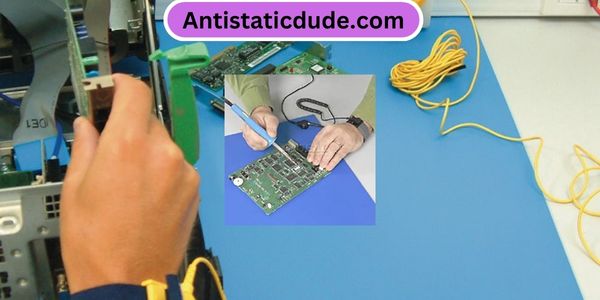When navigating the realm of anti-static handling, think of static electricity as a silent, invisible predator lurking in the shadows of your electronic devices.
The precautions you must take are crucial to safeguarding your equipment and preventing potential damage.
From understanding the basics of static electricity to implementing proper grounding techniques and setting up an anti-static workstation, each step plays a vital role in ensuring the longevity and functionality of your electronics.
But what specific tips can help you stay one step ahead of this elusive foe?

Importance of Anti-Static Precautions
Why is it crucial to implement anti-static precautions in your handling procedures?
When it comes to handling sensitive electronic components, static electricity can be a silent killer. Without proper precautions, you risk damaging these components without even realizing it. By incorporating anti-static measures, you’re safeguarding your equipment from potential harm caused by electrostatic discharge.
Static electricity, though invisible, can build up on your body or work surface without warning. This charge, when discharged, can easily fry delicate electronic circuits, rendering them useless. Implementing anti-static precautions, such as using wrist straps, mats, or packaging materials, helps to dissipate any built-up charge and prevent it from reaching your electronic devices.
Incorporating these precautions not only protects your equipment but also saves you the time, money, and frustration that come with accidental damage. Remember, prevention is always better than cure when it comes to static electricity and electronics. So, take the necessary steps to ensure that anti-static measures are a priority in your handling procedures.
Understanding Static Electricity
To better grasp the importance of anti-static precautions in handling electronic components, it’s crucial to understand the fundamentals of static electricity. Static electricity is the imbalance of electric charges within or on the surface of a material. It occurs when certain materials rub against each other, causing electrons to be transferred from one material to the other. This transfer of electrons creates a charge imbalance, leading to the buildup of static electricity.
When working with electronic components, static electricity poses a significant risk. If not managed properly, static electricity can discharge through sensitive electronic parts, damaging them and rendering them inoperable. This is why anti-static precautions, such as wearing wrist straps and using anti-static mats, are essential in preventing static electricity-related damage.
Anti-Static Handling Tips
When handling electronic components, it’s essential to implement anti-static precautions to prevent damage from static electricity.
To minimize the risk of static discharge, make sure to wear an anti-static wrist strap that’s properly grounded to your body. This will help dissipate any built-up static charge from your body before it can transfer to the sensitive electronic parts.
Additionally, use anti-static mats on your work surface to provide a grounded surface for placing components during handling.
Keep components in anti-static bags when not in use to shield them from any potential static buildup in the environment.
When picking up components, avoid touching the metal leads and instead handle them by the edges to prevent any direct contact with sensitive areas.
Proper Grounding Techniques
Implementing proper grounding techniques is crucial for ensuring effective anti-static handling of electronic components. When working with sensitive electronics, following these grounding practices is essential:
- Use ESD Wrist Straps: Wearing ESD wrist straps helps to dissipate any built-up static charge on your body, preventing it from transferring to the electronic components.
- Grounding Mats: Placing grounding mats on your work surface provides an additional layer of protection by allowing any static charge to flow harmlessly into the ground.
- Grounding Cords: Make sure that all equipment, including tools and workstations, are properly grounded using grounding cords to maintain a consistent path to ground for any static electricity.
Anti-Static Workstation Setup

Ensuring your workstation is properly set up to be anti-static is essential for maintaining a safe environment when handling electronic components. Start by selecting an appropriate work surface such as an anti-static mat. This mat will help dissipate any static charges that could potentially damage sensitive electronics. Make sure the mat is connected to a reliable grounding point to effectively discharge any static buildup from your body.
Additionally, use an anti-static wrist strap connected to the same grounding point as the mat. This will ensure that both you and the work surface are at the same electrostatic potential, minimizing the risk of ESD damage. Keep your workstation clean and uncluttered to prevent any accidental static discharge from nearby objects.
Remember to store electronic components in anti-static bags when not in use and handle them only when necessary. By following these simple guidelines, you can create a secure anti-static workstation that protects your electronic devices from potential damage.
Frequently Asked Questions
What Are the Risks of Not Following Anti-Static Precautions in a Workplace Setting?
If you neglect anti-static precautions at work, you risk damaging sensitive electronics, causing data loss, and potentially starting fires. Take heed of these precautions to protect equipment and ensure a safe working environment.
Are There Any Specific Industries or Environments Where Anti-Static Precautions Are Particularly Important?
In certain industries like electronics manufacturing or chemical processing, anti-static precautions are crucial. Failing to follow these measures can result in damage to sensitive equipment or even pose a risk of fire.
How Long Do Anti-Static Measures Typically Last Before They Need to Be Replaced or Renewed?
To maintain anti-static measures, stay vigilant. Inspect regularly for wear or damage. Replace as needed to ensure effectiveness. Your diligence in monitoring and renewing precautions helps to uphold a safe anti-static environment for your equipment and operations.
Can Personal Items, Such as Clothing or Accessories, Affect the Effectiveness of Anti-Static Measures?
Avoid wearing clothing or accessories that generate static electricity, as these can interfere with anti-static measures. Take care to choose appropriate attire to maintain the effectiveness of your anti-static precautions in handling sensitive electronic components.
Are There Any Alternative Methods or Technologies Being Developed for Anti-Static Handling in the Future?
In the future, new methods and technologies will enhance anti-static handling. Stay updated on advancements in this field. Embrace innovation to improve your anti-static measures and protect sensitive equipment from electrostatic discharge risks.
Conclusion
In conclusion, it’s essential to follow anti-static precautions to prevent damage to electronic components. By understanding static electricity and implementing proper handling techniques, you can ensure the safety and functionality of your devices.
Remember to always use grounding techniques and set up an anti-static workstation to minimize the risk of static discharge. Taking these precautions will help you maintain the integrity of your electronics and avoid costly repairs.


Leave a Reply